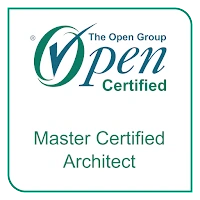Recently, I posted the first part of my journey towards the Master Certified Architect certification. Below, you may read the second part.
In the first part of this post, I ended with my submission of three Experience Profiles, each of which had to be completed by answering some twenty-five to thirty questions. The candidate pursuing for the Open CA certification is asked to paint a detailed picture of multiple projects or programmes he/she has worked on or has been involved with.
Questions, questions
The questions to be answered in the Experience Profiles are not the simplest. I’ve listed some examples below, to give you an idea of what gets asked.
Given approved business goals, objectives, and constraints, describe how you validated and/or elicited them with/from stakeholders. In either case, describe how you captured, documented, clarified, refined, detailed, prioritized, and ensured completeness of both the functional and non-functional requirements.
Given requirements and a list of stakeholders, describe how you explained the present and future state (vision) and how to achieve it, by identifying approaches, tools, techniques, and appropriate solutions so that stakeholders accepted the choices and agreed with the rationale.
Describe how you adapted/tailored, applied/used, and enforced the use of one or more architecture development methods to successfully guide the creation of architectural work products that met the requirements of the work effort.
The entire process of writing an Experience Profile, submitting it, and waiting for validation by a board member takes about one to one and a half months. Since I had to submit three Experience Profiles, this resulted in a turnaround time of over four months.
Certification Application
Next came preparing and submitting the Certification Application. This is an in-depth report of multiple projects or programmes conducted over a period of the past eight years. The previously submitted Experience Profiles may be used as the subject matter in the preparation of the Certification Application.
The question format of the Certification Application addresses the previously described experiences in a different way. The Certification Application can best be regarded as an even more in-depth document (compared to the Experience Profiles) in which specific questions are asked with respect to, for example, the architecture design choices that were made during the execution of the projects. What was previously described in an Experience Profile as an architectural design choice now needs to be explained. The answer to the “why”-question is important here; how did you arrive at this specific design choice and which alternatives did you consider.
This step is challenging but also very interesting to carry out. The way the questions are formulated really makes you think about the work you’ve done and the choices you’ve made. A solid rationale for the choices made is required.
Shortly after submitting the Certification Application, I received notification from The Open Group that a review team was being assembled and that I would be receiving invitations to interviews from three board members in the near future. Days later, the interviews were scheduled. The tension was rising…
Board members themselves hold a certification of at least the same level as the one the candidate is pursuing. In my case, I had to deal with three Distinguished Architects (level three). The interviews were not conducted in a question and answer kind of style; all three board members put effort into creating a real conversation about the field of architecture. This resulted in very enjoyable and interesting conversations. I even gained new LinkedIn connections as a result.
The long wait
At the end of the three sessions, the waiting began for me. The board members would consult on my contribution during the interviews and pass on their feedback to The Open Group. After about a week, I received the liberating answer: I had passed!

I can recommend this course to every architect. It really makes you think about activities carried out during projects or programmes. It forces you to describe those things that you normally do more or less on autopilot. You are asked to take a close look at your own activities and make a substantive judgment about them. It is an eye-opener on several levels.
It is a lot of work, but the appreciation you feel after being awarded the certification is absolutely satisfying.
If you’ve missed part 1/2, please click here. You may also want to check out the webinar I presented on this topic.







Leave a Reply